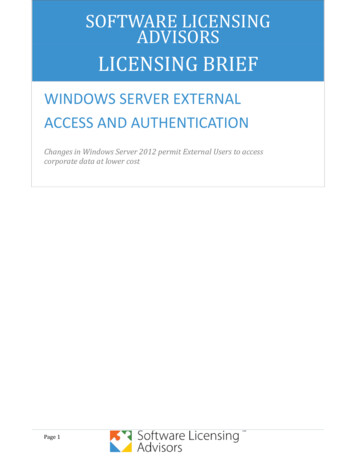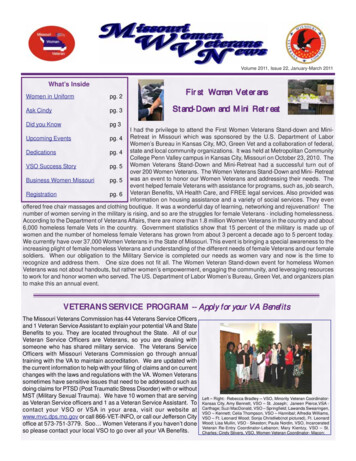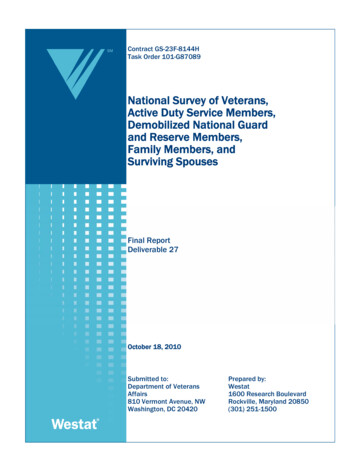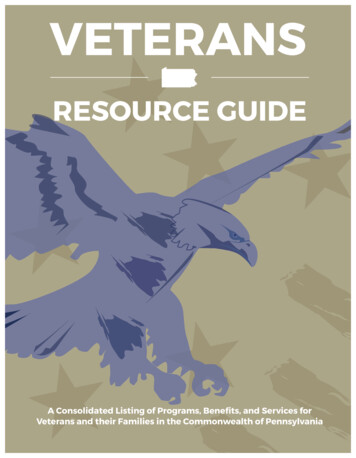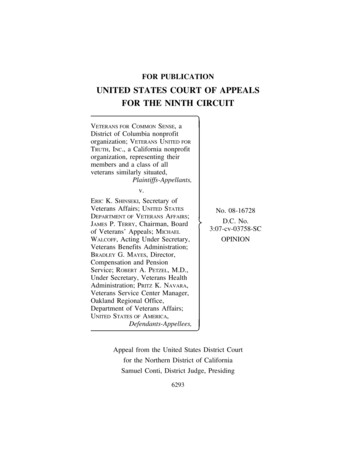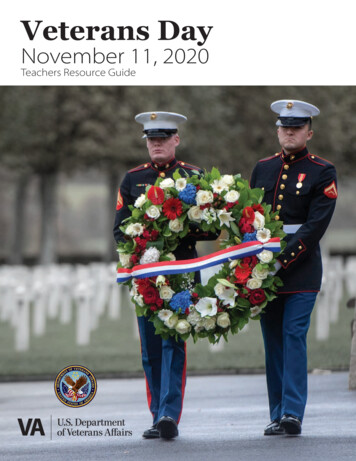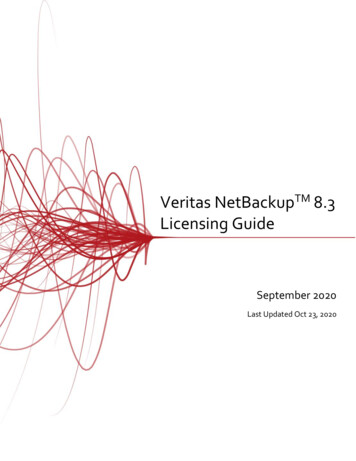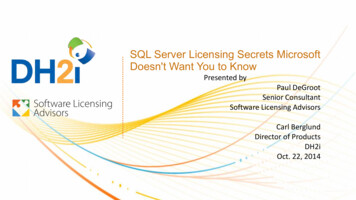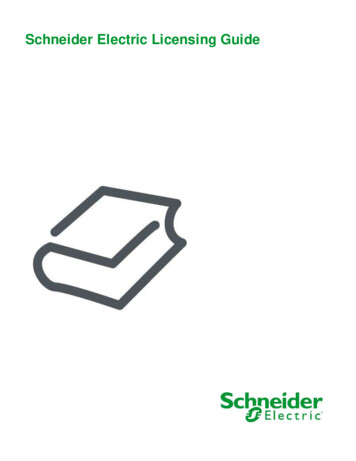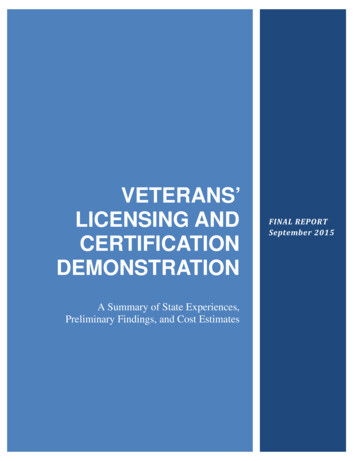
Transcription
VETERANS’LICENSING ANDCERTIFICATIONDEMONSTRATIONA Summary of State Experiences,Preliminary Findings, and Cost EstimatesFINAL REPORTSeptember 2015
VETERANS’ LICENSING AND CERTIFICATIONDEMONSTRATION: A Summary of StateExperiences, Preliminary Findings, and CostEstimatesThis report was prepared for the U.S. Department of Labor under Contract No. DOLJ131A22038.The views expressed herein are those of the contractor. No official endorsement by the U.S.Department of Labor or should be inferred, nor does the mention of trade names, commercialproducts, or organization imply endorsement of same by the U.S. government.Prepared by:National Governors Association Center for Best PracticesWorkforce Development ProgramPrepared for:U.S. Department of LaborEmployment and Training AdministrationOffice of Policy Development and ResearchOn behalf of theVeterans’ Employment and Training Service
September 2015AcknowledgementsThis report was prepared by a team led by Brent Parton with the National Governors AssociationCenter for Best Practices (NGA Center) and Amanda Dunker, formerly with the NGA Center.The report includes significant contributions from a broader project team including Martin Simonand Alisha Powell with the NGA Center, and Elise Shanbacker and Iris Palmer, formerly with theNGA Center. The report additionally benefitted from the contributions of the team at Solutionsfor Information Design (SOLID), including Ed Davin, Karen White, Lisa Lutz, and Bill Brigman.Valuable peer-review comments were provided by David Moore, Elliot Schwartz, and JenniferBrooks (NGA Center) and by Gloria Salas-Kos and Pamela Frugoli (U.S. Department of Labor).We also express our gratitude for the substantial support received from the staff of several otherFederal Agencies and national organizations during the planning and implementation phases ofthe state demonstrations and the NGA Policy Academies. Contributors to the planning,implementation and the NGA Policy Academies include: Marion Cain from the U. S.Department of Defense (DoD) (Readiness); Commander Mitchell Seal, Medic Education andTraining (Ft. Sam Houston); Doctor Maryann Alexander, National Council of State Boards ofNursing; Dia Gainor, National Association of State EMS Officials; Severo Rodriguez and TerryMarkwood with the National Registry of Emergency Medical Technicians; LTC ArturoCalzadillas, Jr. with Soldier for Life; Selden Fritschner, U. S. Department of TransportationFederal Motor Carrier Safety Administration; Dr. Leslie Adrian of the Federation of State Boardsof Physical Therapy; John Awtrey, Law Enforcement Policy and Support, DoD; Steve Gonzales,American Legion Veterans Employment and Training Division; Rodrigo Garcia, StudentVeterans of America; and Bob Simoneau of the National Association of State WorkforceAgencies.
This page is intentionally left blank
ContentsList of Exhibits . iiExecutive Summary . 1Introduction . 7About the Demonstration Project . 9About the Report . 11Part One: Blueprint for Accelerating Veterans’ Licensing and Certification . 12State Strategies to Address Barriers to Veterans’ Liscensing and Certification . 12Process for Designing and Implementing Strategies. 16Implementing State Strategies. 25Conclusion . 27Part Two: Demonstration Cost Study . 29Objective of the Cost Study . 29Cost Study Methodology and Analysis . 30Cost Study Findings . 37Conclusion . 49Appendix I: National Scan of State Executive Orders and Legislation 2013-2015 . 51Appendix II: Demonstration Specific Executive Orders and Legislation . 60Appendix III: Summary of Demonstration State Strategies and Results by Occupation. 62Appendix IV: Demonstration Cost Study Background and Approach . 72Appendix V: Occupation Specific Resources from Demonstration . 74i
List of ExhibitsExhibit 1: Selected States and Occupations .10Exhibit 2: State Strategies to Accelerate Veterans Licensure and Certification . 13Exhibit 3: Process for Designing and Implementing State Strategies . 17Exhibit 4: The National Council of State Boards of Nursing Gap Analysis . 22Exhibit 5: Occupations Not Included in Cost Study Analysis . 30Exhibit 6: State Demonstration Programs by Occupation, Program Status and Program Type For LPN andParamedic . 32Exhibit 7: VOW Act Cost Elements . 33Exhibit 8: LPN Standard and Accelerated Pathway Data by State . 37Exhibit 9: LPN Pathway Comparison - Potential Tuition Savings per Participant by State . 38Exhibit 10: LPN Pathway Comparison - Potential Time Savings per Participant by State . 39Exhibit 11: LPN Pathway Comparison - Potential Monthly Housing Allowance (MHA) Savings perParticipant by State 40Exhibit 12: LPN Pathway Comparison - Average Potential Savings per Participant Across DemonstrationStates . 40Exhibit 13: Summary LPN Pathway Comparison - Average Potential GI Bill Savings per ParticipantAcross Demonstration States . 41Exhibit 14: Paramedic Standard and Accelerated Pathway Data by State 41Exhibit 15: Paramedic Pathway Comparison - Potential Tuition Savings per Participant by State . 42Exhibit 16: Paramedic Pathway Comparison - Potential Time Savings per Participant by State . 43Exhibit 17: Paramedic Pathway Comparison - Potential Monthly Housing Allowance (MHA) Savings perParticipant by State 44Exhibit 18: Summary Paramedic Pathway Comparison - Average Potential Savings per Participant AcrossDemonstration States . 44Exhibit 19: Summary Paramedic Pathway Comparison - Average Potential GI Bill Savings per ParticipantAcross Demonstration States . 45Exhibit 20: LPN Pathway Comparison - Potential Monthly UCX Savings per Participant by State 46Exhibit 21: Paramedic Pathway Comparison - Potential UCX Savings per Participant by State . 47Exhibit 22: UCX Waiver Status and Length of Programs for LPN and Paramedic . 47Exhibit 23: Calculation of a Cross-Program Per-Veteran Estimate of Employment Service Costs . 48ii
Executive SummaryMilitary servicemembers on active duty are the beneficiaries of extensive training that preparesthem to perform in a range of occupational specialties. Some of those occupational specialtieshave direct or proximate equivalents in the civilian workforce, but transitioning servicemembersmight lack the relevant civilian occupational credentials required under federal or state law or byan employer to secure employment. Thus, despite their relevant skills and experience, veteranscan encounter lengthy processes and requirements to obtain the credentials needed to entercivilian employment. Those processes and requirements can impose additional time and financialcosts on veterans and taxpayers, who pay both for the initial military training and for re-trainingoutside of the military, primarily through veterans’ federal education benefits.In response, the federal government has undertaken several initiatives to streamline credentialingand licensing for veterans. Those initiatives include efforts to provide civilian credentials andidentify equivalencies between military and civilian occupations. However, ultimate authority forregulating entry into most professions lies with state governments. The nation’s governorsrecognize that authority and have made assisting veterans in transitioning from military service tocivilian life and employment a priority. As thousands of men and women return fromdeployments at home and abroad, states have launched and expanded programs to help veteranstransition to civilian life. Thirty-nine states issued executive orders or passed legislation to assistveterans in transferring skills gained in military service to civilian employment between 2013 and2015 (See Appendix I and II). In addition, for Commercial Driver’s Licenses (CDLs), all 50states have implemented the Military Skills Test Waiver according to the specific administrativeprocedures applicable within each state. 1To help accelerate such efforts, section 237 of Veterans’ Opportunity to Work to Hire Heroes Actof 2011 (the VOW Act) amended section 4114 title 38 of the United States Code. That legislationauthorized a demonstration project to engage governors in streamlining veterans’ credentialingand licensing. The ultimate goal of section 237 is to identify the most efficient process formoving veterans into civilian employment in an industry with high growth or high workerdemand. 2 The VOW Act directed the U.S. Department of Labor (DOL), through thedemonstration project, to identify state-level professional requirements that are met throughmilitary training and strategies to remove barriers to relevant credentials and licenses. The VOWAct also directed DOL to complete a cost study to inform Congress about the potential federalcost savings of removing barriers at the state level.DOL contracted with the National Governors Association Center for Best Practices (NGACenter) to carry out an 18-month demonstration project. In partnership with DOL, the NGACenter developed a competitive process to select six states to participate in the 18-monthdemonstration: Illinois, Iowa, Minnesota, Nevada, Virginia, and Wisconsin. 3 Each demonstrationstate selected up to three high-demand occupations to focus their licensing and credentialingstrategies that corresponded with one of the three pre-selected military occupational specialties:Medic (Army 68W, Navy Hospital Corpsman, Air Force 4N0X1), Police (Army 31B, NavyMaster-At-Arms, Air Force 3P0X1, Marine Corps 5811), and Truck Driver (Army 88M, MarineCorps 3531) (see Exhibit 1).1Military Skills Test Waiver; U.S. Department of Transportation238 U.S.C. section 4114 (a), as amended by the Veterans’ Opportunity to Work to Hire Heroes Act of 2011(VOW Act), Section 237; Public Law 110-181; H.R. 674, 112th Congress.3Participating states hereinafter are referred to as “demonstration states.”1
Exhibit 1: Selected States and adaVirginiaWisconsinPolicePatrolOfficer EmergencyMedicalTechnician/Paramedic LicensedPracticalNurse RegisteredNursePhysicalTherapyAssistant About the ReportThis final project report on the Veterans’ Licensing and Certification Demonstration wasprepared as a summary of state experiences and preliminary findings to date. The report’sfindings emerged from the authors’ direct engagement with states and review of state projectreports describing their processes and strategies. The report does not attempt to evaluate thesuccess of demonstration state efforts, and findings should be considered preliminary as in manyinstances demonstration states continue implementation of veterans’ pathways to licensure andcertification. Findings in this final report are organized in the following three sections: An introduction describes further background on the demonstration project and thetechnical assistance activities for the six demonstration states. Part one organizes findings from the state demonstration into a blueprint that can informother state-led efforts to accelerate veterans’ licensing and certification. Part two describes the findings from the demonstration cost study, which estimatespotential federal cost savings for veterans participating in accelerated licensure pathways.Key Findings from the State DemonstrationA number of factors can affect the ability of servicemembers and veterans to attain civiliancredentials on a timely basis. The demonstration states encountered three types of barrierscommonly encountered by transitioning servicemembers and veterans: Veterans who have military training and experience that is equivalent to that of licensedcivilians often find that civilian licensing boards are not accustomed to recognizing themilitary documentation of their training and experience. Veterans that experience gaps between their military training and experience and civilianrequirements may have to participate in duplicative training to attain relevant licensure orcertification.2
Administrative rules and processes within civilian licensing and credentialing systemsmay create hurdles for veterans to obtain licensure or certification unrelated to theirability to competently provide professional services to the public.Demonstration state strategies to address those barriers were shaped by both occupational andstate specific complexities. In turn, the demonstration identified several strategies for states toaccelerate the licensing and certification of veterans based on the particular challenge at hand.(See Exhibit 2.) In short, the main challenges and strategies are: To address equivalency challenges, states can assess the equivalency of military trainingcourses and use official documentation to permit veterans with fully or partiallyequivalent training and experience to sit for civilian licensure examinations or licenseveterans by endorsement (officially recognize military training and experience to meetcivilian requirements). To address training gaps, states can work with education institutions to set up acceleratedprograms for veterans that bridge gaps, provide veterans advanced standing in existingprograms, or offer bridge courses that prepare veterans to enter existing programs. Finally, to address administrative or process challenges, states can assess any non-skillrelated requirements that might disadvantage veterans, such as fees or length ofexperience, or take steps to make civilian employment pathways friendlier to veteransthrough concerted outreach to both veterans and prospective employers.Exhibit 2: State Strategies to Accelerate Veterans Licensure and CertificationBarriers to CivilianLicensure/CertificationRelevant State StrategiesDemonstration ExamplesVeterans, with professionalpreparation equivalent to that oflicensed civilians, receivesubstantially differentdocumentation for their militarytraining and work experiencesfrom the types ofdocumentation commonlyrecognized by civilian licensingboards. License veterans withequivalent training byendorsement. Permit veterans with similartraining to become licensed bypassing an exam.Iowa’s EMS Office reviewedtraining for military medics andapproved it as sufficient formeeting the state’s EMT trainingrequirements. Former medicswith an active national EMTcertification can apply for anEMT license in Iowa and inother states.Veterans who are unable todocument the equivalency oftheir prior professionalpreparation may be required toattend training that isduplicative of their militarytraining and experience. Provide course credit andadvanced standing in existingtraining or degree programs. Develop bridge courses thatprepare veterans to enterexisting programs.Administrative rules andprocesses create hurdles forveterans to obtain licensure orcertification unrelated to their Assess non-skill requirementsto identify opportunities forstreamlining. Assess the take-up on existingNevada developed a curriculumfor preparing medics to becomeLPNs. The curriculum reducesthe training time by half.Wisconsin combined award ofcredit, bridge coursedevelopment and entry to anexisting program with advancedstanding.Previously, Wisconsin requiredveterans to secure a lawenforcement position beforeallowing them to take the law3
Exhibit 2: State Strategies to Accelerate Veterans Licensure and CertificationBarriers to CivilianLicensure/Certificationability to competently provideprofessional services to thepublic.Relevant State Strategiesaccelerated pathways forveterans to identify possibleimprovements.Demonstration Examplesenforcement exam. Now, byallowing veterans to take theexam before receiving anemployment offer, the exam candemonstrate their knowledge topotential employers.Although state strategies differed as a result of occupational and state specific requirements, thedemonstration experience surfaced a common process—a blueprint across states andoccupations—for designing and implementing strategies to accelerate the licensure andcertification of veterans. That process included: Assemble a TeamSelect the OccupationsUnderstand Civilian Employment Requirements and StakeholdersUnderstand Military Occupational SpecialtiesProduce Gap Analysis to Identify the Appropriate StrategyMarket to VeteransDevelop Assessment PlanFrom this implementation approach, demonstration states made progress on strategies across theselected occupations. Appendix III provides a detailed overview of state strategies by occupation,and describes state progress and results to date on those strategies. The overview organized byoccupations and strategies, highlights the progress made in reciprocity, examinations, bridgeprograms, advanced standing, and administrative processes and rules to accelerate occupationallicensing and certifications for veterans. To summarize: Five states implemented policies to allow veterans to apply for licensure reciprocity, andthree states implemented protocols to allow veteran licensure by examination.All six states engaged in the development of bridge programs, three of which wereoperational by the close of the demonstration period.Five states put in place strategies to grant advanced standing to veterans in trainingprograms.Three demonstration states implemented strategies to streamline administrative rules andprocesses.These state experiences, with implementing the selected strategies, offer a set of lessons learnedand implications for other state and federal stakeholders to consider when in pursuing similarefforts: The governor’s office is important to mobilize the number and diversity of state agenciesinvolved and to take executive action and coordinate any required statutory changes withthe state legislature.4
Cross-state communication and collaboration is important to confirm the feasibility ofdeveloping accelerated pathways and identify strategies to facilitate their implementation.That includes communication between state licensing boards and postsecondaryeducation institutions, and their governing state education agencies, to negotiate theoperational details of accelerated pathways to civilian licensure. National associations of state licensing boards can expedite state-level efforts byproviding a foundation for designing occupation-specific curricula that support theimplementation of accelerated pathways. Demonstration states continue to struggle with the limited availability of state-levelinformation on the military occupational specialties of transitioning servicemembers andrecently separated veterans, which makes it difficult to estimate the level of demand foraccelerated pathways for the different civilian occupations and to prioritize theoccupations to be targeted for pathways.Key Findings from the Demonstration Cost StudyIn addition to a demonstration project to document state strategies, the VOW Act of 2011 calledfor the development of a cost study estimating potential federal cost savings as a result of stateefforts to accelerate veterans’ licensure and certification. The cost study compiled key areas ofpotential federal cost savings associated with demonstration states’ efforts. Those potential costsavings include: Less time spent in training can lead to potential deferred federal government costs in theform of fewer dollars expended by the Department of Veterans Affairs (VA) under thePost-9/11GI Bill for tuition and monthly housing allowance benefits; 4 Less time spent securing employment can lead to potential cost savings for the federalgovernment in the form of fewer dollars expended by the Department of Defense (DOD)for Unemployment Compensation for Ex-Service members (UCX) benefits and by theDOL for the delivery of employment services.The availability of data from states developing accelerated programs was primarily driven by theimplementation status of the program. Thus, demonstration data restricted the scope of the coststudy analysis to two high-demand occupations for which demonstration states developedaccelerated programs: Licensed Practical Nurse (LPN) and Paramedic. Those analyses found that: Across the four accelerated LPN programs, the demonstration programs generated apotential per participant reduction in time of 71 percent and a potential 68 percentreduction in combined GI Bill benefits deferred. Participants reduced the time spent intraining by 10 months and potentially avoided an average combined GI Bill benefits of 18,100 per participant ( 3,900 in deferred tuition benefits and 14,200 in deferredhousing allowance benefits).4The Post 9/11 GI Bill provides up to 36 months of education benefits, generally available for up to 15 years afteractive duty service. Such benefits may include a monthly housing allowance, an annual books and supplies stipend,and a one-time rural benefit payment; Source: http://www.benefits.va.gov/gibill/post911 gibill.asp5
The three accelerated paramedic programs in the demonstration states generated apotential per participant reduction in time of 29 percent and a potential 28 percentdeferral of combined GI Bill benefits. Participants reduced the time spent in training by 4months and potentially avoided an average combined GI Bill costs of 7,400 perparticipant ( 1,750 in deferred tuition benefits and 5,650 in deferred housing allowancebenefits). Neither the LPN nor the paramedic accelerated programs generated any potential savingsto the UCX benefits. However, the cost study did determine that certain conditions thatmust be met to achieve potential savings in UCX benefits: oA state must offer veterans in training a waiver from meeting the work test forUCX eligibility, which allows them to collect UCX benefits while participatingin an accelerated program; andoThe accelerated program must allow for completion before UCX eligibility isexhausted.Finally, to estimate the potential cost savings to DOL of delivering employment servicesto veterans, a cost per veteran served was calculated for the demonstration states as agroup by dividing the proportion of funding allocated to veterans by the Wagner-Peyserand Jobs for Veterans State Grants by the number of Wagner-Peyser participants who areveterans. 5 That calculated cost—of approximately 200 per veteran at the demonstrationlevel—represents the estimated potential savings in employment service costs for eachveteran who does not seek public workforce services as the result of successfullyparticipating in an accelerated civilian licensure program.The results of the cost study suggests that the amount of the GI Bill benefits deferred and theproportion of the deferred GI Bill benefits attributable to housing allowance benefit are consistentwith the findings of a companion credentialing report to Congress in response to Section 558 ofthe FY2012 National Defense Authorization Act (NDAA). 6 In examining the potential costsavings attainable by making civilian credentialing opportunities available during militaryservice, that report concluded that the availability of those opportunities is expected to producecost savings through post-service avoidance of federal costs for living expenses. Thedemonstration’s cost study analysis similarly indicates that the primary federal cost savingsattainable to state efforts to accelerate the civilian credentialing of veterans arise from a reductionin costs for living expenses under the GI Bill.5The Wagner-Peyser Act of 1933 established a nationwide system of public employment offices known as theEmployment Service, or the One-Stop services delivery system. Employment Services focuses on providing a varietyof employment related labor exchange services including but not limited to job search assistance, job referral, andplacement assistance for job seekers, re-employment services to unemployment insurance claimants, and recruitmentservices to employers with job openings. The Jobs for Veterans State Grants Program (JVSG) provides veteransemployment services through the One-Stop system through funding for Disabled Veterans Outreach Program (DVOP)specialists and Local Veterans Employment Representative (LVER) staff.6“Pilot Program: Civilian Credentialing for Military Occupational Specialties, Vol. 1” United States Department ofDefense, September 27, 2013.6
IntroductionMembers of the United States’ military are trained in hundreds of occupations with relevance tothe civilian workforce. Ideally, veterans could turn their training and work experience intocivilian jobs. However, many civilian occupations have regulated pathways for entry, with fewaccessible mechanisms to recognize skills developed outside of those pathways. Some veteransfind that, despite training and experience relevant to the civilian workforce, they must start fromthe beginning to obtain the formal documentation and training required to enter their occupationof choice. Those administrative and duplicative training requirements can impose additional costson veterans and taxpayers, who pay for both the initial training provided by the military and thenfor re-training outside of the military through veterans’ education and unemployment benefits.Recognizing these challenges, the Federal government has focused on several initiatives toaccelerate civilian licensing and certification for veterans. The initiatives undertaken resultedfrom new intergovernmental efforts across Federal agencies, including the military, to identifyequivalencies between military and civilian occupations and provide civilian credentials.Examples of such efforts include: The Department of Defense Credentialing and Licensing Pilot Program. 7 Section 558 ofthe National Defense Authorization Act (NDAA) for Fiscal Year 2012 (FY12) directedthe Department of Defense (DoD) to carry out a pilot program to assess the feasibility ofallowing enlisted members of the Armed Forces to obtain civilian licenses or credentialsin occupations related to five military occupational specialties, including aircraftmechanics, automotive mechanics, health care support, logistics and supply, and truckdrivers. A report submitted to Congress in September 2013 provides further details aboutservices and costs related to both in-service and post-service funding and credentialingcosts for veterans. 8 The Veterans Employment Initiative (VEI). 9 VEI is a joint task force between the DoDand the Department of Veterans Affairs that began in September 2012. The Departmentof Labor and Department of Education, as well as the Small Business Administration, arealso involved in the task force. Among other employment issues, the VEI focuses onthree areas of study related to licensing and credentialing: assessment of servicecredentialing programs; assessment of gaps between military training and civiliancredentialing requirements; and study of methods to promote assessment of militarytraining and experience by civilian credentialing agencies. The Joining Forces Military Spouse Licensing Initiative. 10 In 2013, the Administrationexpanded an existing program for military spouses to include licensing and credentialingfor veterans and separating servicemembers. The existing program launched in 2012addressed the portability of licenses across state lines for military spouses, whofrequently practice in professions, such as teaching and nursing that require a license atthe state level. In February 2013, the White House released a report on veterans’licensing and credentialing initiatives titled The Fast Track to Civilian Employment:7Pellerin, Cheryl. “Credentialing Effort Helps Troops Enter Private Sector." US Department of Defense. September 3,2014.8“NDAA Section 558 – Military Credentialing Pilot Program: Volume 1,” United States Department of Defense,September 27, 2013, ToCongress VOL 1-FINAL.pdf9"Executive Order 13518 - Veterans Employment Initiative." The White House. November 9, 2009.10"About Joining Forces." The White House.7
Streamlining Credentialing and Licensing for Service Members, Veterans, and TheirSpouses. 11 The Department of Defense Credentialing Task and Licensing Force. 12 The Task Forceworks to identify and create opportunities for servicemembers to earn civilianoccupational cre
accelerate the licensing and certification of veterans based on the particular challenge at hand. (See Exhibit 2 .) In short, the main challenges and strategies are: To address equivalency challenges, states can assess the equivalency of military training courses and use official documentation to permit veterans with fully or partially
